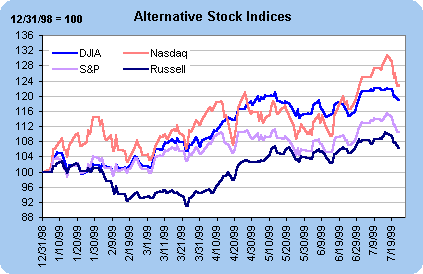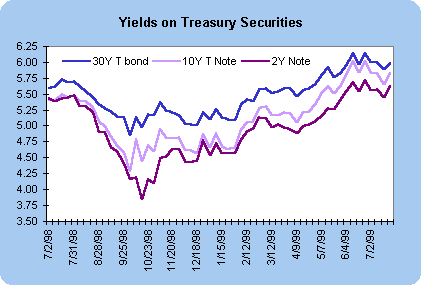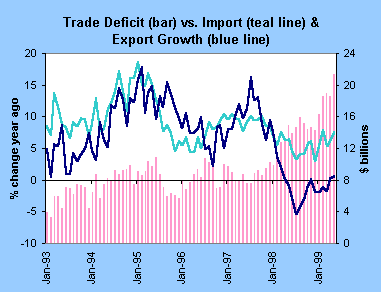
|
Today's Calendar |
| | Simply Economics |
| | International Perspective |
| | Resource Center |
 |
|
| 1999 Articles |
|
By Evelina M. Tainer, Econoday Chief Economist Greenspan upsets financial markets . . . again
Equity prices retrace steps since June 30 The Fed chairman's Humphrey-Hawkins testimony was not particularly bearish in the whole scheme of things. It's just that Greenspan didn't offer any remarks that would be considered bullish for the markets. As a result, market players used the Greenspan testimony as an excuse to sell and take profits.  It is worth noting that even after the week's drop in stock prices, the Dow and the NASDAQ are simply back to levels seen at the end of the second quarter. Remember that the growth exhibited in the first half of the year would be sufficient to make the stock market gains quite healthy by historical standards! The S&P 500 and the Russell 2000 have not increased as dramatically since quarter end, and have come down a bit more sharply than the Dow and the NASDAQ in the past week. Interesting tidbit: Since 1990, the Dow has declined sharply in at least one of the summer months. (We loosely describe summer as June, July, August and September.) Since 1995, the declines were concentrated in July or August (or both.) In 1997 and 1998, the declines registered in August were quite dramatic indeed.
Interest rates rise again 
Greenspan's semi-annual Humphrey-Hawkins testimony spooks markets Our reading of the Greenspan testimony is in line with that of the press reports. There is no question that the Fed is closely monitoring conditions - and is poised to act on excessive economic growth or bad inflation reports. Alan Greenspan said, "The already shrunken pool of job-seekers and considerable strength of aggregate demand suggest that the Federal Reserve will need to be especially alert to inflation risks. Should productivity fail to continue to accelerate and demand growth persist or strengthen, the economy could overheat." Greenspan spent quite a bit of time discussing productivity issues. Indeed, he noted the sharp improvement in productivity growth in the past few years. He also expected that productivity gains would continue in the future. But he pointed to the difficulty in forecasting productivity and technology gains. Greenspan brought up an interesting point that the media ignored. One of the issues that has been at the forefront is the concept of full employment. Basically, when an economy reaches full employment, additional growth is likely to exacerbate inflationary pressures. The civilian unemployment rate previously associated with full employment was roughly 5 1/2 percent. In the past couple of years, few Fed officials have indicated their views on what they believe to be the full employment unemployment rate. In the past 12 months, the unemployment rate has remained well below 4 1/2 percent! Greenspan notes, "…when productivity is accelerating, it is very difficult to gauge when an economy is in the process of overheating." In an indirect way, he is suggesting that full employment is a moving target. The unemployment rate becomes somewhat less useful in determining at what point inflationary pressures will be set off. The Fed chairman does go on to say that employment growth has exceeded the growth in the working age population this past year. He believes this implies that real (inflation-adjusted) GDP is growing faster than its potential. Incidentally, this is not the first time that the Fed chairman has shifted his attention from the unemployment rate to employment growth. Apart from his worries that excessive growth in the United States could lead to inflationary pressures, Greenspan notes that the risks of financial disruptions from overseas, have diminished. In addition, as foreign economies grow at a faster clip, prices of imported goods will be less likely to curtail domestic prices. All in all, our reading of the Greenspan testimony suggests that the Fed is fully prepared to raise the federal funds rate target an additional 25 basis points at the August 24 FOMC meeting. However, Fed officials have not yet decided what they will do at that meeting as they wait for additional data on economic growth and inflation in the next four weeks. It remains a toss-up at this point.
Housing starts slide in June  Some analysts consider that the shortage of construction materials, such as gypsum board is a major contributing factor to the slower activity. That may be one of the contributing factors. It is possible that the underlying demographic trends are finally coming into play. After all, the demographics would have pointed to starts closer to a 1.5 million unit rate over the past two years. A sustained slowdown in housing construction will eventually lead to a moderation in consumer spending on furnishings and appliances. It will also act as a drag on residential investment spending on GDP growth in the second and third quarters of this year.
International trade deficit widens  These days, economic activity in Germany and Italy is on the soggy side, but much of Europe is showing improvement. This points to some pick up in export demand in coming months. Southeast Asia is in the midst of a modest recovery. It is too soon to expect tremendous growth in export demand from this part of the world, but at least it is no longer declining. It is politically correct to complain about the foreign sector and how all the imports are taking away jobs from U.S. workers. One should note that the foreign sector played a major role in holding down prices in the past couple of years. Given that U.S. activity may have overheated, the ability to purchase imported goods has helped alleviate pressures here.
THE BOTTOM LINE The main concern this week were the comments made by Fed chairman Alan Greenspan before the House Banking Committee for the semi-annual Humphrey-Hawkins testimony. Market players saw Greenspan as hawkish, although his remarks were actually not indicating an imminent rate hike. Market participants are forward-looking -- and already anticipating next week's news. It is a relatively heavy week for economic figures, including two key ones: GDP and the employment cost index. This will give the Fed, economists, and market players something to mull on with respect to growth and inflation.
Looking Ahead: Week of July 26 to 30
Monday
Tuesday
Wednesday Alan Greenspan will address the Senate Banking Committee for part 2 of the Humphrey-Hawkins testimony.
Thursday The employment cost index is expected to rise 0.8 percent in the second quarter after a more modest 0.4 percent gain in the first three months of the year. This translates to a 2.8 percent gain on a year-over-year basis and is down from the 3 percent yearly rise posted in the previous quarter. This indicator is a Fed favorite and will be closely monitored by all. Economists are predicting that real GDP will grow at a 3.4 percent rate in the second quarter, a slower pace relative to the previous two quarters. (Real GDP expanded at a whopping 6 percent rate in the fourth quarter of 1998 and at a 4.3 percent rate in the first three months of this year.) At the same time, the implicit price deflator should rise at a 1.6 percent rate - the same as the previous quarter's hike. Slower consumption expenditures, a drop in residential construction, and a drag from the foreign trade sector are key reasons behind the slower growth.
Friday New home sales are expected to increase 1.4 percent in June to a 900,000 unit rate. This is at odds with the drop in single family housing starts reported last week. Typically the two series move in tandem. Markets might be surprised by these figures. |
|||||||||||||||||||||||||||||||||||||||||||||||||||||||||||||||||||||||||||||||||||||||||||